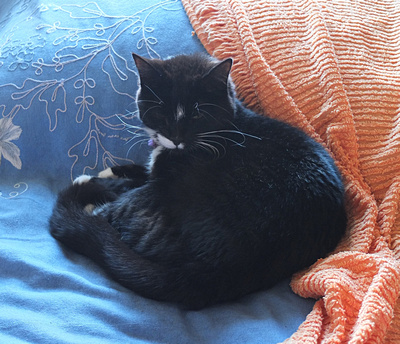Welcome to what may seem to be a pretty random blog - it won't be all (or probably even mainly!) about photography, but more about our interests, things we've learnt and other stuff!
Our lives are pretty well filled with doing "stuff" - we very much enjoy the outdoors (unless it's raining heavily) and we are often gardening, fishing or doing other "outdoors" stuff. We also can end up working on our land rovers - currently a Series 3 Diesel and a 300TDi 90 - as they need some loving after a hard life!
When the weather is miserable (or the tides are wrong for fishing) we may end up indoors. The XBox is a great temptation and so is card making and crafting! Of course, there is always a pressure stove or lamp that needs polishing or playing with too!
For those of you that are interested in classic pressure stoves and lamps, there will be some information and thoughts :)
NOTE: Word usage is (mostly) in accordance with Proper English (i.e. not American english) so gas = gas and not petrol. Paraffin = Kerosine etc.
Size Does Matter!
So if you have decided that you would like a paraffin pressure stove, what next? Well by the title of this post you'll be expecting that there is, of course, something else to consider...
And that something is SIZE! Yes, size does matter. And by that, I'm referring to the size of the stove. You see, if there's only one or two of you hiking, you probably don't want to be carrying around a large base-camp size stove and if there's four of you camping, you probably want something a bit bigger than the Primus/Optimus 96 stove shown in my last post.
With paraffin pressure stoves, there are several common sizes. The capacity in pints is how much paraffin the tank can hold.
- 1/2 pint [e.g. Optimus/Primus 96]


- 1 pint [e.g. Optimus 00, Primus 210]
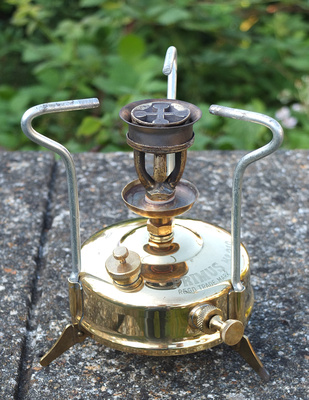

- 1 3/4 pint [e.g. Optimus 45]
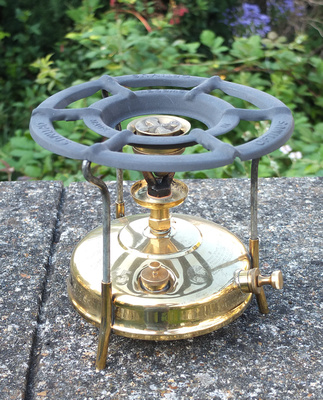

- 2 pint [e.g. Optimus 1, Optimus/Primus 5]


There are, of course, bigger stoves out there but they will be hard to find or expensive (and we're "keeping it simple" here)!
All but the 2 pint stoves are basically "packable" - in other words, they can be partially dismantled so they can fit in a box (although there are "packable" 2 pint stoves, but good luck finding them - and if you do, please share photos on CCS!)
As a basic rule of thumb, the 1/2 pint stove is a 1 - 2 man stove, the 1 pint stove a 2 - 3 man stove and the 1 3/4 pint stove is for 3 - 4 (or more). The 1 3/4 pint is a "base-camp" stove really - it's not suited to being carried in a backpack unlike the 1/2 or 1 pint stoves! The 2 pint stoves are also base-camp and home cooking stoves.
Here is a comparison...
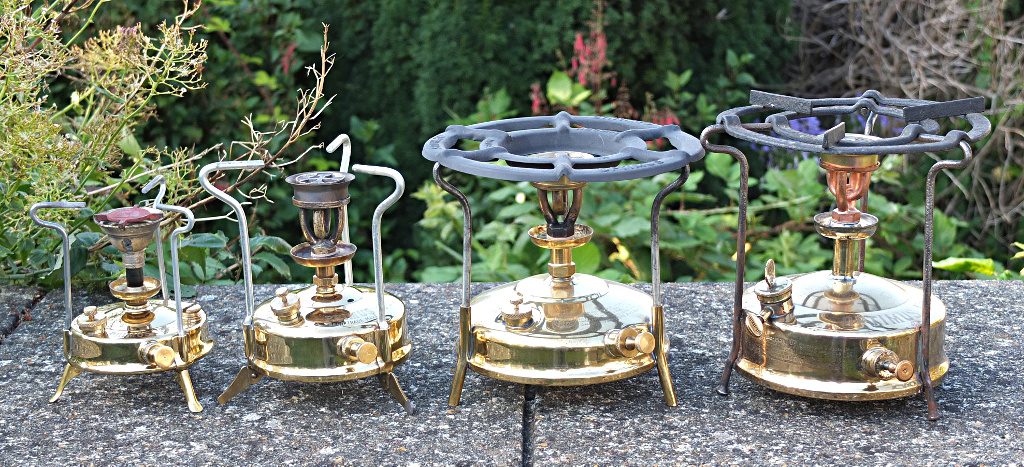
 Left to Right: Primus 96, Primus 210, Optimus 45, Optimus 1.
Left to Right: Primus 96, Primus 210, Optimus 45, Optimus 1.
The different stoves are not just different sizes, they also have different size burners and have different heat outputs. There's info out there (see http://www.spiritburner.com/fusion/index.php) on the different heat outputs for different burners, but I'm not going in to it here! As a basic guide, assume that from the 1/2 to the 1 3/4 pint stove, heat output increases!
Hopefully, this gives you an idea of which size stove you want - you could of course get one of each! If you do, beware the Dark Side (known to mere mortals as compulsive stove purchasing!) :)
Next I hope to address the vexed question of loud or quiet. It's not just a matter of personal preference ;)
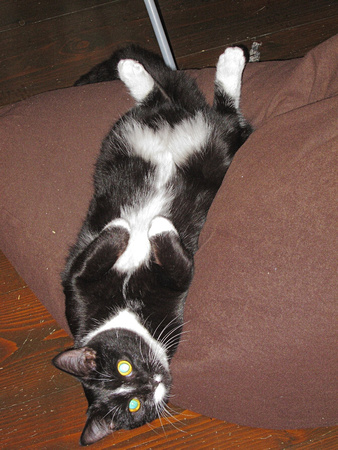

Paraffin vs Petrol
It's pretty apparent that I prefer the classic stoves over the more modern ones! That doesn't mean that I don't own a few of the more recent stoves though! However, an important consideration for me is which fuel.
Simply put, pressure stoves can use paraffin or petrol (and some meths too but we'll ignore that for now!)
This is a small paraffin stove - the Primus 96. It's a one - two man stove but with a lot of power for its small size!

 This is a stove I will happily use indoors (safely) which I have done on many occasions - it's perfect for brewing coffee on in the perculator which can't be used on a modern electric hob...
This is a stove I will happily use indoors (safely) which I have done on many occasions - it's perfect for brewing coffee on in the perculator which can't be used on a modern electric hob...
This is a small petrol stove - the Optimus 80. It's a one man stove only - the tin underneath is a combined tin AND pot holder so that gives you an idea of the size of pots that can be used with it (hint, not very large!). The SVEA 123 in my previous post also runs on petrol but one can use larger pots on it!
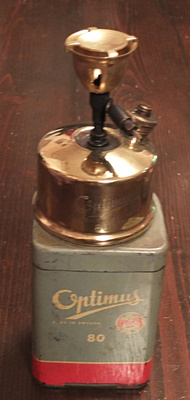
 Funnily enough, I don't use this indoors... Interestingly, it is safe enough to use indoors if nothing goes wrong and it doesn't overheat. If it does overheat, there is a safety valve. If that opens, pressure is released from the stove body along with a cloud of petrol vapour. I shouldn't need to explain why this could be very bad - especially indoors! (Remember that the stove would still be lit at the time of the pressure release and that petrol vapour is highly flammable).
Funnily enough, I don't use this indoors... Interestingly, it is safe enough to use indoors if nothing goes wrong and it doesn't overheat. If it does overheat, there is a safety valve. If that opens, pressure is released from the stove body along with a cloud of petrol vapour. I shouldn't need to explain why this could be very bad - especially indoors! (Remember that the stove would still be lit at the time of the pressure release and that petrol vapour is highly flammable).
So why does the Optimus 80 have an automatic pressure relief valve and the Primus 96 not? Simply, the Optimus 80 self pressurizes, there is no pump to pressurize the fuel as due to the volativity of petrol it isn't needed (unless you're in the arctic!).
With the Primus 96, the flame is easily controllable by manually opening the pressure relief valve (vent) to reduce flame and pumping with the built in pump to increase the flame - the paraffin vapour released doesn't catch fire!
Now there are Coleman stoves out there that are much safer than the venerable Optimus 80 (and being bigger are much more useful!) however, the issue of the low vapour point of petrol still remains an issue. Interestingly, our dual fuel Coleman (dual feather) runs hotter on paraffin (using the paraffin "generator") than on petrol (using the petrol "generator") so a comparable paraffin stove cooks quicker than a petrol one...
To be completely fair, there is one advantage that the petrol stoves have over paraffin stoves (especially the older ones with no quick light function) and that is that the same fuel can be used to prime the stove whereas with paraffin stoves you need to either have flammable alcohol gel or some meths handy.
As paraffin is so much safer (especially when things go wrong) it is a fuel I am much more comfortable using, more so since others that are less familiar with this sort of technology use my stoves too!


Why retro?
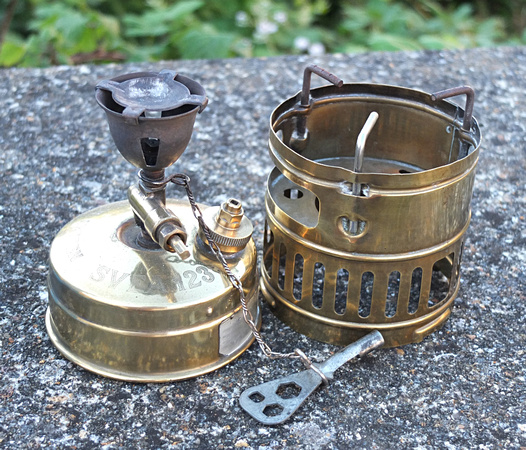

I guess it's odd to some people why anyone would want to have an "old" car or an "old" motorbike. Somehow you're assumed to be either rich or odd. I suppose that the second one applies even if the first doesn't...
It gets even better when you use the old brass camp stoves or pressure lamps. People can't understand why you don't use a new gas stove or a battery lantern. So why do I bother?
Simply put, for the price of a new paraffin/multifuel stove you can get maybe four (or more!) classic stoves. They LOOK great and you get the satisfaction of refurbishing an old (and tarnished) stove to nearly as-new condition. Yes it does take time and effort but the rewards are well worth it!
There's also very little difference in performance between a modern paraffin stove and an old Primus! The old stoves are so well designed that they have similar (or identical) heat output.
So if a classic stove is really this great, why don't more people use them? Why do rivet counters in the classic car and land rover scene who are anal about being 100% accurate with their restorations use more modern stoves and not an older stove? Having used many different stoves over the years, one answer is convenience! In the time it takes to prime and light a paraffin stove, a gas stove is already lit. The gas is in a nice convenient canister and it's just "plug and play". Unfortunately, as those of us that have older gas stoves have found out, occasionally those nice convenient canisters of gas stop being available. You then have to either buy a new stove (expensive) or find some way of re-filling an old canister (potentially dangerous). The canisters for the new gas stoves also aren't cheap!
Have a look at the below, from left to right, a new campinggaz screw on burner, a 1980's campinggaz Bluet and a classic SVEA 123. Which would you prefer?
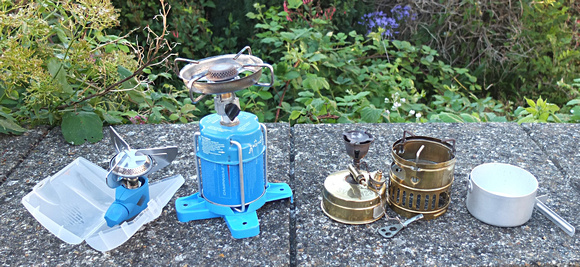

So instead of a gas stove, we could get an Optimus Omnifuel or similar - a great modern stove that runs on paraffin or petrol or meths. Yes it'll light quicker, but how long is it going to last? Odds are it won't be usable after twenty years, let alone eighty. Yes there really are brass pressure stoves that old that still work just as well as the day they were made!! Unfortunately, modern stoves just aren't as well made as older kit and are going to need more care to ensure they don't break.
For me, a classic pressure stove is the perfect camp stove - cheap, durable, easy to fix, easy to light and reliable. The fuel is easy to get hold of too and even at current over-inflated prices is still cheaper than buying gas canisters!
